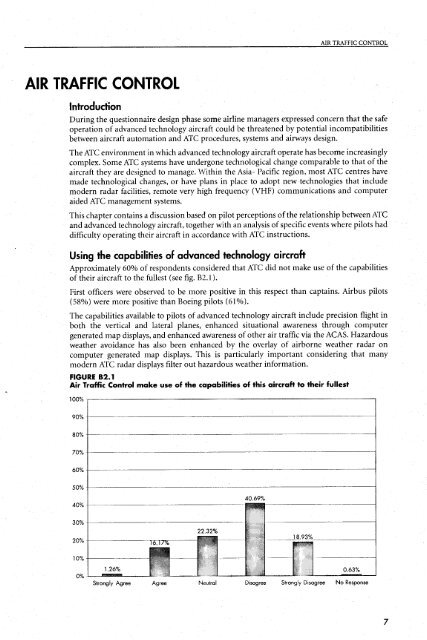Advanced Technology Aircraft Safety Survey Report - Australian ...
Advanced Technology Aircraft Safety Survey Report - Australian ...
Advanced Technology Aircraft Safety Survey Report - Australian ...
You also want an ePaper? Increase the reach of your titles
YUMPU automatically turns print PDFs into web optimized ePapers that Google loves.
AIR TRAFFIC CONTROL<br />
AIR TRAFFIC CONTROL<br />
Introduction<br />
During the questionnaire design phase some airline managers expressed concern that the safe<br />
operation of advanced technology aircraft could be threatened by potential incompatibilities<br />
between aircraft automation and ATC procedures, systems and airways design.<br />
The ATC environment in which advanced technology aircraft operate has become increasingly<br />
complex. Some ATC systems have undergone technological change comparable to that of the<br />
aircraft they are designed to manage. Within the Asia- Pacific region, most ATC centres have<br />
made technological changes, or have plans in place to adopt new technologies that include<br />
modern radar facilities, remote very high frequency (VHF) communications and computer<br />
aided ATC management systems.<br />
This chapter contains a discussion based on pilot perceptions of the relationship between ATC<br />
and advanced technology aircraft, together with an analysis of specific events where pilots had<br />
difficulty operating their aircraft in accordance with ATC instructions.<br />
Using the capabilities of advanced technology aircraft<br />
Approximately 60% of respondents considered that ATC did not make use of the capabilities<br />
of their aircraft to the fullest (see fig. B2.1).<br />
First officers were observed to be more positive in this respect than captains. Airbus pilots<br />
(58%) were more positive than Boeing pilots (61%).<br />
The capabilities available to pilots of advanced technology aircraft include precision flight in<br />
both the vertical and lateral planes, enhanced situational awareness through computer<br />
generated map displays, and enhanced awareness of other air traffic via the ACAS. Hazardous<br />
weather avoidance has also been enhanced by the overlay of airborne weather radar on<br />
computer generated map displays. This is particularly important considering that many<br />
modern ATC radar displays filter out hazardous weather information.<br />
FIGURE B2.1<br />
Air Traffic Control make use of the capabilities of this aircraft to their fullest<br />
100%<br />
90%<br />
80%<br />
70%<br />
60%<br />
50%<br />
40%<br />
30%<br />
20%<br />
10%<br />
0%<br />
40.69%<br />
Strongly Agree Agree Neutral Disagree Strongly Disagree No Response<br />
7
















